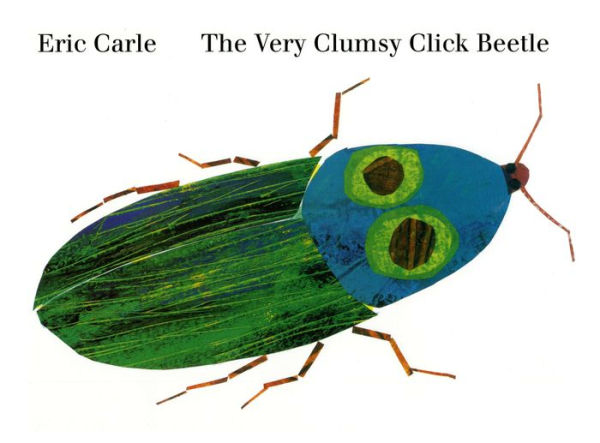Whether you have an aspiring bug catcher who’s practicing his pincer grip by capturing moths mid-flight or a preschooler who runs away screaming at the mere mention of something creepy crawly (or perhaps a little of each), these books are sure to capture your child’s imagination while giving them new insights into the wonderful world […]
The Very Clumsy Click Beetle
From bestselling author and illustrator Eric Carle, the creator of The Very Hungry Caterpillar, comes another classic tale about one very clumsy click beetle. A perfect gift to share with the child or grandchild in your life.
When a little click beetle falls onto his back, he seeks the help of a wise old click beetle. "Look at me," says the more experienced click beetle, giving a loud CLICK and flipping onto its feet. But try as he might, the clumsy little click beetle just can't get the hang of it—or can he? In the tradition of The Very Hungry Caterpillar, Carle creates a winning story of perseverance and pride in achievement complete with an ingenious fiber-optic microchip that truly gives voice to the valiant little beetle as it CLICKs its way through the colorful pages and somersaults into your heart.
Praise for The Very Clumsy Click Beetle:
"Sure to be loved and requested again and again, Click Beetle is a well-crafted story, joyfully illustrated, that speaks to the hearts of young children."—Library Journal
"At once stark and sophisticated, Carle's trademark collage art fills the pages of his latest Very volume."—Publishers Weekly
"Carle's trademark artwork, featuring large, colorful collages set against expansive white space, is—as always—a strong attribute."—Booklist
1101571524
When a little click beetle falls onto his back, he seeks the help of a wise old click beetle. "Look at me," says the more experienced click beetle, giving a loud CLICK and flipping onto its feet. But try as he might, the clumsy little click beetle just can't get the hang of it—or can he? In the tradition of The Very Hungry Caterpillar, Carle creates a winning story of perseverance and pride in achievement complete with an ingenious fiber-optic microchip that truly gives voice to the valiant little beetle as it CLICKs its way through the colorful pages and somersaults into your heart.
Praise for The Very Clumsy Click Beetle:
"Sure to be loved and requested again and again, Click Beetle is a well-crafted story, joyfully illustrated, that speaks to the hearts of young children."—Library Journal
"At once stark and sophisticated, Carle's trademark collage art fills the pages of his latest Very volume."—Publishers Weekly
"Carle's trademark artwork, featuring large, colorful collages set against expansive white space, is—as always—a strong attribute."—Booklist
The Very Clumsy Click Beetle
From bestselling author and illustrator Eric Carle, the creator of The Very Hungry Caterpillar, comes another classic tale about one very clumsy click beetle. A perfect gift to share with the child or grandchild in your life.
When a little click beetle falls onto his back, he seeks the help of a wise old click beetle. "Look at me," says the more experienced click beetle, giving a loud CLICK and flipping onto its feet. But try as he might, the clumsy little click beetle just can't get the hang of it—or can he? In the tradition of The Very Hungry Caterpillar, Carle creates a winning story of perseverance and pride in achievement complete with an ingenious fiber-optic microchip that truly gives voice to the valiant little beetle as it CLICKs its way through the colorful pages and somersaults into your heart.
Praise for The Very Clumsy Click Beetle:
"Sure to be loved and requested again and again, Click Beetle is a well-crafted story, joyfully illustrated, that speaks to the hearts of young children."—Library Journal
"At once stark and sophisticated, Carle's trademark collage art fills the pages of his latest Very volume."—Publishers Weekly
"Carle's trademark artwork, featuring large, colorful collages set against expansive white space, is—as always—a strong attribute."—Booklist
When a little click beetle falls onto his back, he seeks the help of a wise old click beetle. "Look at me," says the more experienced click beetle, giving a loud CLICK and flipping onto its feet. But try as he might, the clumsy little click beetle just can't get the hang of it—or can he? In the tradition of The Very Hungry Caterpillar, Carle creates a winning story of perseverance and pride in achievement complete with an ingenious fiber-optic microchip that truly gives voice to the valiant little beetle as it CLICKs its way through the colorful pages and somersaults into your heart.
Praise for The Very Clumsy Click Beetle:
"Sure to be loved and requested again and again, Click Beetle is a well-crafted story, joyfully illustrated, that speaks to the hearts of young children."—Library Journal
"At once stark and sophisticated, Carle's trademark collage art fills the pages of his latest Very volume."—Publishers Weekly
"Carle's trademark artwork, featuring large, colorful collages set against expansive white space, is—as always—a strong attribute."—Booklist
25.99
In Stock
5
1

The Very Clumsy Click Beetle
32
The Very Clumsy Click Beetle
32
25.99
In Stock

Product Details
| ISBN-13: | 9780399232015 |
|---|---|
| Publisher: | Penguin Young Readers Group |
| Publication date: | 09/13/1999 |
| Pages: | 32 |
| Product dimensions: | 11.73(w) x 8.63(h) x 0.72(d) |
| Lexile: | AD470L (what's this?) |
| Age Range: | 3 - 5 Years |
About the Author
From the B&N Reads Blog
